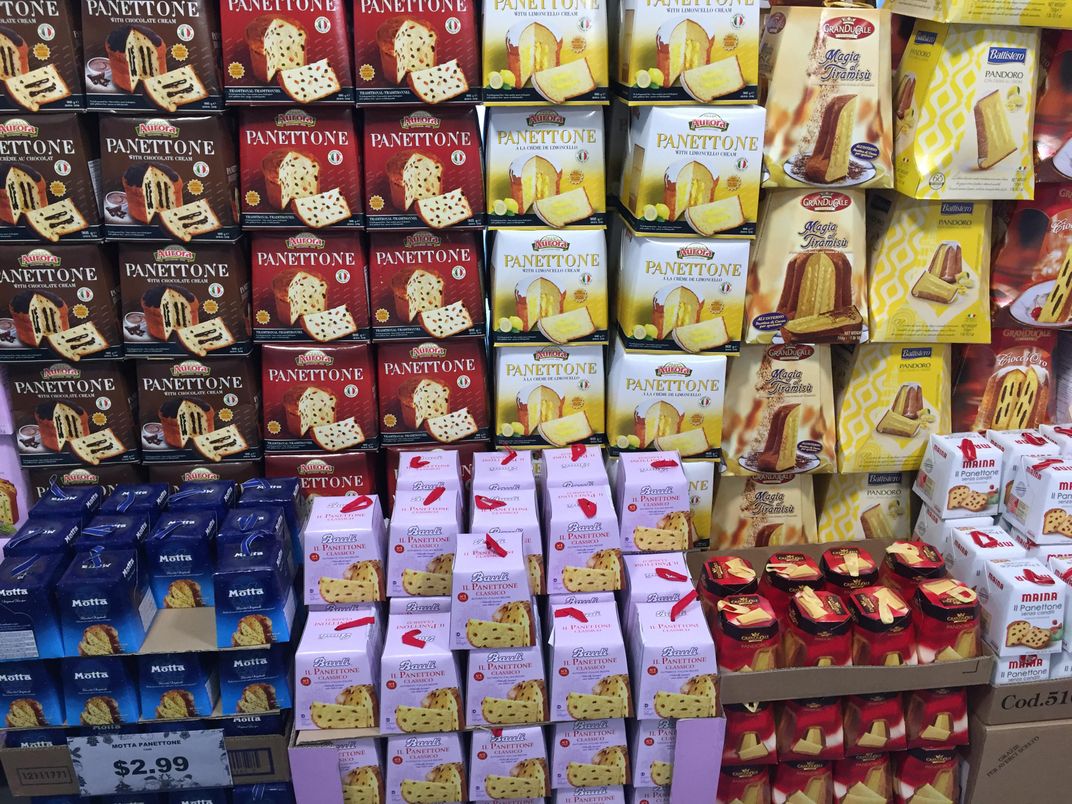A Culinary History of Panettone, the Italian and South American Christmas Treat
The holiday pastry has been a multicultural phenomenon since the very beginning
/https://tf-cmsv2-smithsonianmag-media.s3.amazonaws.com/filer/b8/cf/b8cf3954-53ec-488d-b87d-bb17a93e8d59/6527569819_8003122da6_b.jpg)
A few years back, pastry executive Alberto Bauli spoke with a heightened sense of panic during a press conference for an Italian consortium of bakers and confectioners.
“Seven out of 10 Americans buying an ‘Italian-style’ panettone are getting a fake,” he proclaimed.
Panettone—the world-famous, yeast-leavened cake, whose sales reach their peak during the weeks before Christmas—had been forced into “unfair competition,” cried Bauli, with inferior knock-offs baked abroad. Italy produces more than 7,100 tons of panettone each year—about ten percent of which is sold internationally. It’s a source of national pride, and, since 2005, had been one of over a hundred foods subject to a formal authentication process under Italian law. Within Italy, panettone has been considered a homegrown, Lombard specialty since the 19th century, when cookbooks, such as Giovanni Felice Luraschi’s 1853 Nuovo cuoco milanese economico, placed the roots of the original recipe firmly in the area around Milan. (The pastry was first mentioned in a manuscript from the 1470s, written by a preceptor in Milan’s House of Sforza.)
It was more than unfair that a product with such a rich cultural history should have to share shelf space with imitators from the Americas, Bauli argued. Unless something was done—perhaps with the help of the World Trade Organization—the very face of Italy’s gastronomic history was at risk of serious damage.
Tenuous origins of the seven-out-of-ten statistic aside, we can hardly blame Bauli—the second-generation president of one of the country’s best-known panettone makers—for presenting himself as a kind of defender of the faith. In Italy, the rules for making the delicacy are as strict as ever: in order to be labeled as such, a native panettone must be composed of no less than 20 percent candied fruit, 16 percent butter, and eggs that are at least four percent yolk. Attempts by the Italian agriculture ministry to have these standards applied abroad have not panned out, and the reality is that panettone is a dessert with many homes.
Panettone has actually been a worldly product from the very beginning. From the Middle Ages onward, the pastry was appropriate for a feast day precisely because it involved ingredients that were hard to come by. In the 15th century—a period in which bread flour usually involved cheaper grains like spelt and rye—the first panettone was made entirely from wheat flour, and thus more likely to impress the in-laws. And given the climate of northern Italy, additions like candied citron or orange peel would have had to come from hundreds of miles away, beyond, perhaps, even the borders of modern-day Italy.
“Panettone was not born as a homemade cake, nor has it ever been,” says Stanislao Porzio, a food scholar and author of a 2007 book on the subject. “It was never important that the place of provenance of the ingredients be near the place of preparation.”

In other words, nothing is inherently inauthentic about a panettone made in the Western hemisphere. In the 1930s, when Angelo Motta was installing a 100-foot conveyor belt in his bakery on Milan’s Viale Corsica to create what Porzio calls the world’s first “industrial panettone,” an entrepreneur named Antonio D’Onofrio had already established a market for the pastry in Lima, Peru, where thousands of immigrants from Piedmont and Lombardy had arrived since the mid-1800s. Today, the brands of Motta and D’Onofrio (now owned by Nestle) compete in the Peruvian marketplace, where slices of panettone—inflected with bits of dried papaya—is the sweet of choice for both Christmas and Independence Day, celebrated in July. Italy may dominate in global panettone consumption, at a rate of 75 million cakes purchased in 2016, but Peruvian fans are no less sincere. They consumed 42 million panettoni in the same year, sometimes enjoying variations like cocatón, in which about five percent of the flour is made from coca leaves, or by incorporating a fruity edible fungus native to the pine forests around Lambayeque.
In sales, Italian confectioners have been outpaced for a long time by companies like Bauducco, another multi-generational enterprise, founded in the 1950s by an Italian immigrant to Brazil. The company is probably the biggest panettone producer on earth, making more than 200,000 tons each year for more than 50 countries and operating six industrial bakeries, including one in the United States.
“It’s a tradition that goes back generations,” says Ricardo Bastos, a Brazilian grocer in the Astoria section of Queens, New York. Bastos sells Bauducco’s panettone year-round at his store, Rio Supermarket, though the brand is also available at bigger retailers like Publix and CVS. “My favorite is the one with condensed milk. I don’t know how many we sell, but it’s a lot.”
Stanislao, the historian, admits to having tasted the Bauducco brand himself, and gave it a tactful review. (“It had a different, romantic character.”) He remains passionate about preserving the traditions of panettone-making in his home country and is the sponsor of a petition on Change.org to have the recipe recognized as a valuable cultural artifact by Unesco. In 2008, he launched Re Panettone (“Panettone King”), an annual competition in Milan aimed at promoting panettone variations made by artisanal bakers and pastry-makers. While far-off ingredients like saffron or tonka bean are welcome, entrants eschew the use of preservatives—even those somehow permitted by the Italian Pastry and Pasta Association—and are rewarded for their attention to detail and respect for the original formula.
“In one sense, no one can take this away from Italy,” Porzio says. “Even if a panettone is made in Australia, the recipe remains milanese.”